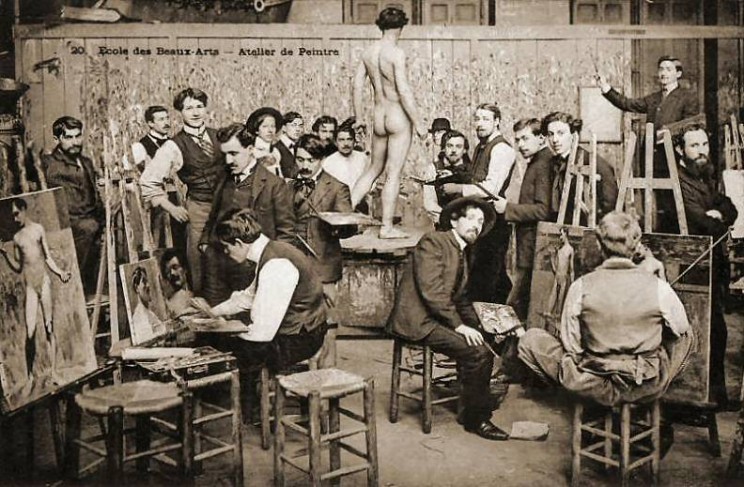By Kandice Rawlings
Summer is over and it’s back-to-school season. Art students are heading back to their classrooms and studios, receiving a course of training that will help them become professional artists. Much of the general public today likely has an image of the working artist as a glamorous intellectual, a socially-conscious provocateur, or a tradition-busting bohemian who has received a course of formal training, resulting in a fine arts degree. But these stereotypes and the reality they approximate—and the institutions that have contributed to it in one way or another—are relatively recent phenomena.
For most of history, the artist in the West (Europe and its colonies) was a craftsman who was trained as an apprentice in the workshop of a senior artist (‘master’). By working under the master and paying him a fee, an apprentice would learn the technical aspects of his craft—how to mix pigments, prepare wood panels for painting, or handle a chisel and hammer—as well as standard motifs and compositions that would suit his patrons. (I use the male pronoun here deliberately—professional women artists were unknown until the Renaissance period and were still extremely scarce until the 19th century.) After several years of training (usually in adolescence), an apprentice could apply for guild membership and open his own workshop.

Students painting ‘from life’ at the École des Beaux-Arts, Paris. Late 1800s. Photograph in the public domain via Wikimedia Commons.
This model persisted in most of Europe until the 17th and 18th centuries, when state-sponsored art academies became widely established. The institution of the academy has its roots in Renaissance Italy, where humanist scholars, famous artists, and their patrons set out to reshape the visual arts as intellectual endeavors. While the medieval artist was a craftsman, the same as a cobbler or a weaver, the Renaissance artist—a good one, anyway—was a genius and a scholar. He (and, increasingly, she) therefore required a new kind of education, to learn about classical culture, literature, philosophy, theology, science, and mathematics, all of which were deemed essential to the production of good art. The first academy (named after Plato’s school in ancient Athens) was established in Florence in 1563, soon followed by one in Rome. By the end of the 18th century, every major European state boasted at least one academy of art. The National Academy of Design was founded in New York in 1825, based on the British model of independence from government involvement. The course of study at the academies was highly standardized and was based largely on classical forms and subjects, and the study of live models and plaster casts. Artists not trained at academies might instead learn similar skills in a successful artist’s studio, similar to the medieval master/apprentice relationship, with an updated curriculum.
By the late 19th century, after decades of political upheaval throughout Europe and the United States, the academy came to be seen by many artists as a sclerotic arm of the state. Academic artists turned out technically astute but formulaic work, some of it openly propagandistic. The emergence of the avant-garde prompted many artists to break institutional ties, forgoing academy-sponsored exhibitions (in France, these were the famous Salons) and trying to make their way without the help or influence of the establishment. (Thus the image of the artist as a struggling outsider was born.) In the late 19th and early 20th centuries, groups of artists established schools that were alternatives to the academy, such as the Art Students League in New York and the Bauhaus design school in Germany. A break from academic norms also opened doors for so-called self-taught artists with no formal training at all.

Exterior of the Bauhaus workshops, Dessau. Photo by PeterDrews (Own work). CC-BY-SA-3.0 via Wikimedia Commons.
How do artists fare after their formal education has finished? Statistics and studies from different countries provide a mixed picture, but a recent survey revealed that Americans holding fine arts degrees have a rate of unemployment (4%) well below the national average and report a high level of satisfaction in their jobs.
Kandice Rawlings is Associate Editor of Oxford Art Online at Oxford University Press. Before joining OUP, she studied Italian Renaissance art and taught art history at Rutgers University. Her students included many talented artists and performers studying at the Mason Gross School of the Arts.
Oxford Art Online offers access to the most authoritative, inclusive, and easily searchable online art resources available today. Through a single, elegant gateway users can access — and simultaneously cross-search — an expanding range of Oxford’s acclaimed art reference works: Grove Art Online, the Benezit Dictionary of Artists, the Encyclopedia of Aesthetics, The Oxford Companion to Western Art, and The Concise Oxford Dictionary of Art Terms, as well as many specially commissioned articles and bibliographies available exclusively online.
Subscribe to the OUPblog via email or RSS.
Subscribe to only art and architecture articles on the OUPblog via email or RSS.
The post Back to (art) school appeared first on OUPblog.



